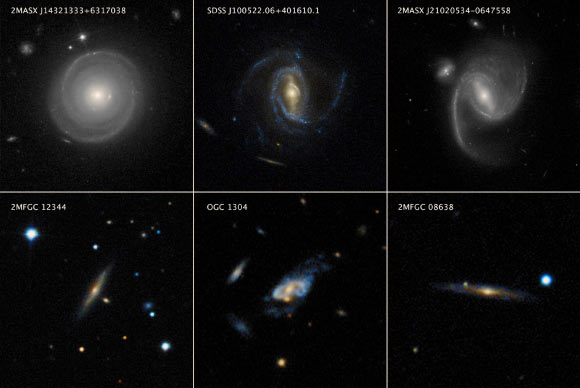Super Spirals Spin Faster Than Expected, Astronomers Say | Astronomy – Sci-News.com
Super spirals are the most massive star-forming disk galaxies in the Universe. They are much larger, brighter, and more massive than our own Milky Way Galaxy. Dr. Patrick Ogle of the Space Telescope Science Institute and his colleagues have found that these enormous galaxies spin faster than expected for their mass, at speeds up to 350 miles per second (570 km/sec); for comparison, the Milky Way — an average spiral galaxy — spins at a speed of 130 miles per second (210 km/sec).

The top row of this mosaic features Hubble images of three spiral galaxies, each of which weighs several times as much as the Milky Way. The bottom row shows three even more massive spiral galaxies that qualify as super spirals, which were observed by the ground-based Sloan Digital Sky Survey. The galaxy at lower right, 2MFGC 08638, is the most massive super spiral known to date, with a dark matter halo weighing at least 40 trillion Suns. Image credit: NASA / ESA / P. Ogle & J. DePasquale, STScI / SDSS.
Super spirals are very luminous — they can shine with anywhere from 8 to 14 times the brightness of our Milky Way Galaxy.
They are also giant and massive, with a diameter up to 450,000 light-years and stellar mass between 30 and 340 billion solar masses.
Only about 100 super spiral galaxies are known to date.
“Super spirals are extreme by many measures. They break the records for rotation speeds,” Dr. Ogle said.
Dr. Ogle and co-authors analyzed data for 23 super spiral galaxies collected with the Southern African Large Telescope (SALT), the 5-m Hale telescope of the Palomar Observatory, and NASA’s Wide-field Infrared Survey Explorer (WISE).
They found that these galaxies significantly exceed the expected rotation rate.
They think that the rapid spin of super spirals is a result of sitting within an extraordinarily massive halo of dark matter.
2MFGC 08638, the largest super spiral studied by the team, resides in a dark matter halo weighing at least 40 trillion times the mass of our Sun.
“It appears that the spin of a galaxy is set by the mass of its dark matter halo,” Dr. Ogle said.
The fact that super spirals break the usual relationship between galaxy mass in stars and rotation rate is a new piece of evidence against an alternative theory of gravity known as Modified Newtonian Dynamics (MOND).
This theory proposes that on the largest scales like galaxies and galaxy clusters, gravity is slightly stronger than would be predicted by Newton or Einstein. This would cause the outer regions of a spiral galaxy, for example, to spin faster than otherwise expected based on its mass in stars.
MOND is designed to reproduce the standard relationship in spiral rotation rates, therefore it cannot explain outliers like super spirals. The super spiral observations suggest no non-Newtonian dynamics is required.
Despite being the most massive spiral galaxies in the Universe, super spirals are actually underweight in stars compared to what would be expected for the amount of dark matter they contain. This suggests that the sheer amount of dark matter inhibits star formation.
There are two possible causes: (i) any additional gas that is pulled into the galaxy crashes together and heats up, preventing it from cooling down and forming stars, or (ii) the fast spin of the galaxy makes it harder for gas clouds to collapse against the influence of centrifugal force.
“This is the first time we’ve found spiral galaxies that are as big as they can ever get,” Dr. Ogle said.
Despite these disruptive influences, super spirals are still able to form stars. Although the largest elliptical galaxies formed all or most of their stars more than 10 billion years ago, super spirals are still forming stars today.
They convert about 30 times the mass of the Sun into stars every year, which is normal for a galaxy of that size. By comparison, our Milky Way forms about one solar mass of stars per year.
The findings were published in the Astrophysical Journal Letters.
_____
Patrick M. Ogle et al. 2019. A Break in Spiral Galaxy Scaling Relations at the Upper Limit of Galaxy Mass. ApJL 884, L11; doi: 10.3847/2041-8213/ab459e





